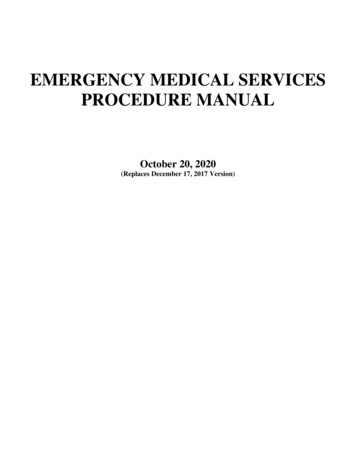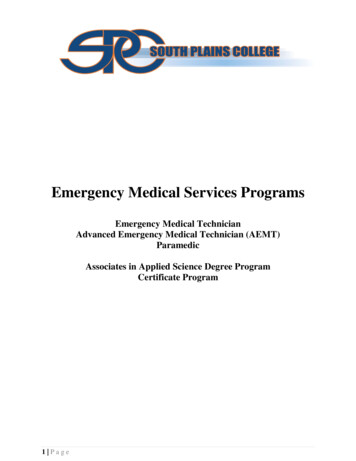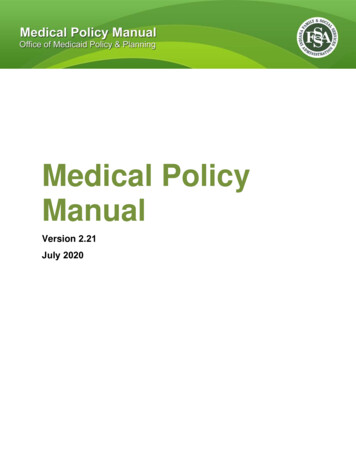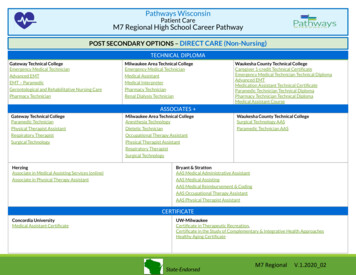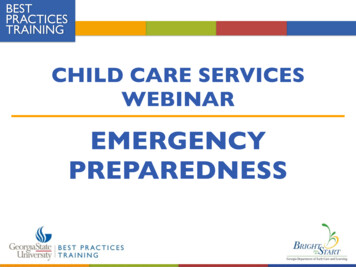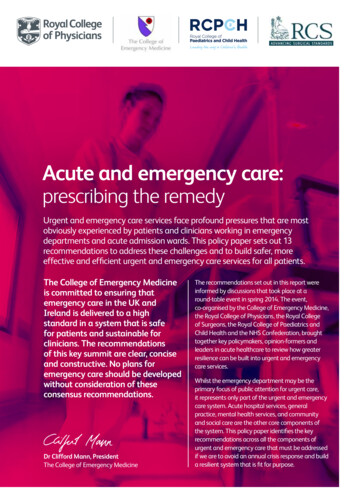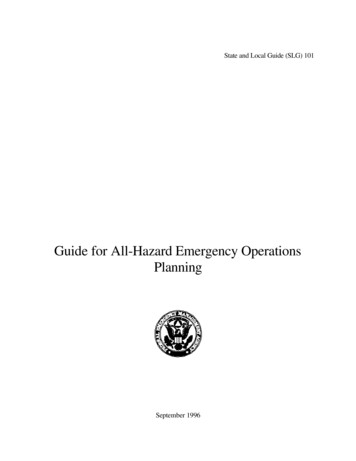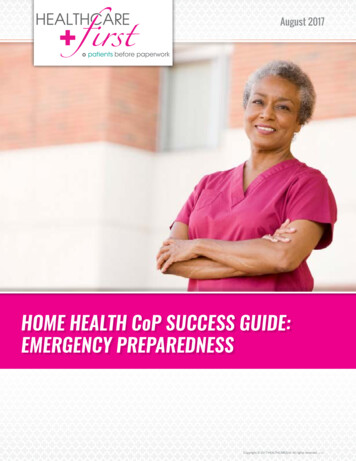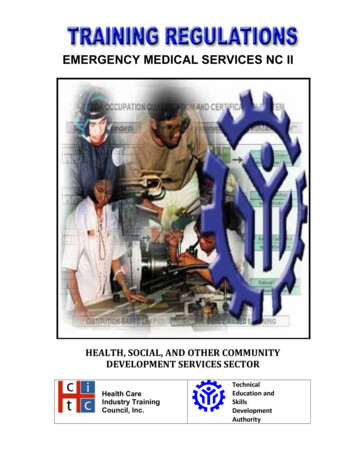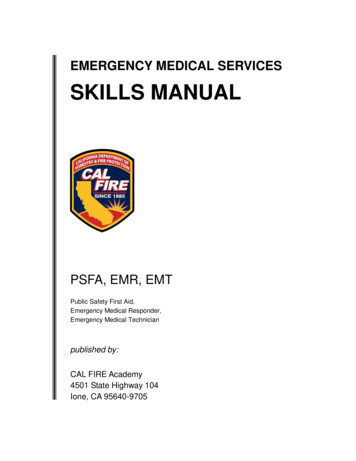
Transcription
EMERGENCY MEDICAL SERVICESSKILLS MANUALPSFA, EMR, EMTPublic Safety First Aid,Emergency Medical Responder,Emergency Medical Technicianpublished by:CAL FIRE Academy4501 State Highway 104Ione, CA 95640-9705
EMSSKILLS MANUALIntroductionTable of ContentsIntroduction .3EMT Certifying Skills Examination Process .3Skills Competency Verification Process .4Organizing the Skills Evaluation .4Facility .4Equipment List .5Staff .5Responsibility of Exam Staff .6Medical Director .6Exam Coordinator .6Skill Station Proctors .6EMS Assistants .7Simulated Patients .7SKILLS .8EMT Skills .9EMR Skills .9PSFA Skills .9Skill Station Management Guide .10Skill Sheets .28Skill #1: Patient Assessment/Management – Trauma Skill Sheet .29Skill #2: Patient Assessment/Management – Medical Skill Sheet .31Skill #3: Upper Airway Adjuncts and Suction Skill Sheet .33Skill #4: Bag-Valve-Mask Apneic Patient Skill Sheet .34Skill #5: Oxygen Administration Skill Sheet .35Skill #6: Mouth-to-Mask with Supplemental Oxygen Skill Sheet .36Skill #7: Cardiac Arrest Management/AED Skill Sheet .37Skill #8: Bleeding Control/Shock Management Skill Sheet .38Skill #9: Spinal Immobilization, Supine Patient Skill Sheet .39Skill #10: Spinal Immobilization Seated Patient Skill Sheet .40Skill #11: Unattached Avulsion or Amputation Skill Sheet .41Skill #12: Long Bone Immobilization Skill Sheet .42Skill #13: Joint Injury Skill Sheet .43Skill #14: Traction Splinting Skill Sheet .44Skill #15: Prehospital Childbirth Skill Sheet .45EMS SKILLS COMPETENCY VERIFICATION FORM .46EMS SKILLS EXAM CHECK LIST .480008 ig.docJanuary 31, 2012Page 2
EMSSKILLS MANUALIntroductionIntroductionThis manual presents a structured, organized approach to conducting EMS skills evaluations.There are two distinct methods utilized to evaluate EMS Skills and the Exam Coordinatormust ensure the proper method is in use. Testing is used to evaluate students completingthe initial EMT course. Competency demonstration/verification is used for all other skillsevaluations EMT Certifying Skills ExaminationSkills Competency VerificationSkills proficiency testing and demonstration is an integral part of the evaluation processrequired of EMS responders. The skill sheets provide specific detail for each EMS skill. Eachsheet lists the critical criteria and specific steps to be completed for each skill. As such, theseskill sheets serve as both a training guide and an evaluation instrument. Each student shouldhave a set of skill sheets and should be responsible to maintain them and bring them to classas directed by the instructor.Each skill will require a careful demonstration by the instructor in conjunction with associatedlecture and simulation instruction during the course of the class. After the demonstration,students should break into small groups and practice using their own skill sheets. Carefulmonitoring of the individual groups will ensure the procedures are fully understood by allstudents. The following is a guide to assist all personnel involved in the testing process.EMT Certifying Skills Examination Process“Certifying Skills Examination” means the National Registry of Emergency MedicalTechnicians (NREMT) EMT skills examination to test an individual applying forcertification as an EMT. Authority: Title 22, Division 9, Chapter 2, §100059.1. (2010)The certifying skills examination must be passed with 80% accuracy. CAL FIRE’s certifyingskills examination meets and exceeds the criteria presented in the NREMT’s (NationalRegistry of Emergency Medical Technicians) Practical Examination Users Guide NREMT Exam Coordinator Documents. These skills should not be modified.Additional skills may be added based upon local scope of practice or Unit-specific equipment;this in turn may change the expected student performance. CAL FIRE has chosen to add twoskills to the NREMT EMT certifying skills examination; skill # 11 “unattached avulsion oramputation” and skill # 15 “prehospital childbirth”.Skill #11 and #15 are required by California for EMT recertification. For CAL FIRE EMStraining consistency those skills have been made a mandatory portion of the NREMT EMTcertifying skills examination.0008 ig.docJanuary 31, 2012Page 3
EMSSKILLS MANUALIntroductionThe certifying skills examination must be completed before taking the final written exam.Students can fail no more than three skills during one examination session or any one skill nomore than three times. Failure to pass the skills examination will result in course failure andthe student will be required to take the course over again in order to be eligible forcertification.For every skill, the student must identify or utilize appropriate body substance isolationprecautions. For every skill, the student will be presented with a given scenario that requiresa specific performance. As the student performs the skill, the proctor will observe theirperformance and note either successful completion or omission of each step. Many stepshave additional components, which depending on their criticality to the scenario may berequired in order to successfully complete the step. The student will be required todemonstrate proficiency for each component labeled as critical criteria, failure to do so isautomatic failure of that skill.Visitors are not allowed in the station while testing is being conducted. The examinationcoordinator, medical director, or proctor in training may audit the station if they are notdisruptive to the testing.It should be understood that the following skills are not a complete description of every skillthat an EMS responder is expected to perform. No realistic test would provide this wide aspectrum of examination. However, these skills do provide a method to satisfactorily ensurethat EMS personnel are able to perform at a prescribed standard in most prehospital medicalemergencies.Skills Competency Verification ProcessSkills Competency Verification shall be utilized for EMT skills recertification, EMRskills and PSFA skills. The Skills Competency Verification method allows for someinstruction or proctor input. Skills competency shall by verified by direct observation of anactual or simulated patient contact. Skills competency shall be verified by an individual whois currently certified or licensed as an EMT, Advanced EMT, Paramedic, RN, PA, or MD. andwho shall be designated by an Unit Training Officer. Skill proficiency must be demonstratedbefore taking the final written exam. Authority: Title 22, Division 9, Chapter 2, §100080.(2010)Organizing the Skills EvaluationFacilityStations for the EMT Certifying Skills Examination should be set up in such a way toprevent students from observing the testing process prior to the time of their testing.Stations for the Competency Verification may be in direct sight of waiting students.Every effort should be taken to limit distractions. The facility should have a waiting area0008 ig.docJanuary 31, 2012Page 4
EMSSKILLS MANUALIntroductionto accommodate the number of students scheduled to test. The waiting area shouldhave chairs and restrooms.Equipment ListThis is an approximate list of equipment needed to complete EMS skills testing. You mayneed more than one of each listed item. See individual “skill station management guide” forequipment needs specific to skill. Personal protective equipmentWatchBlood pressure cuffStethoscopePenlightTapePenNote padTableChairBlanket or mat for patientOxygen tank and regulatorNasopharyngeal airway setOropharyngeal airway setBVM with oxygen tubingSuction unitAirway mannequinCPR mannequinMannequin (optional for splinting)OB mannequin OB kit supplies (Scalpel, OB pad,chux, blanket, towels, gauzesponges, bulb syringe, umbilicalclamps, plastic bags forplacenta, towelettes)Oxygen tank and regulatorPocket mask with oxygen tubingTraining automated externaldefibrillator (AED)BVM with oxygenDressings and bandagingC-Collar adjustable or assortmentBackboard and matching strapsShort board/or KEDHead bed or appropriate necksupportSplinting material (cardboard,SAM splint, wire, other)Splinting material (Sager, Kendrickor other traction device)StaffWhenever possible, it is recommended to form a core group or regular examinationpersonnel. This will help promote teamwork and consistency among the examination staff.Personnel needed to complete skills testing vary depending on the number of studentsinvolved and time parameters. NREMT recommends the following examination staff: One (1) Examination Coordinator (can act as proctor)Six (6) skill station proctorsThree (3) EMS assistantsFour (4) simulated patients0008 ig.docJanuary 31, 2012Page 5
EMSSKILLS MANUALIntroductionResponsibility of Exam StaffMedical DirectorWhile it is not essential to have a physician medical director in attendance at all examinationsessions, it is highly desirable. The skills to be tested and the acceptable levels ofperformance should always be determined with physician medical director input.Exam CoordinatorCoordinators should be currently certified or licensed to perform every aspect of the examprocess. The exam coordinator is responsible for the overall planning, implementation, qualitycontrol and validation of the examination process. Specific duties include orientation of thestudents and documentation of the examination staffSkill Station ProctorsCERTIFYING SKILLS EXAMINATIONProctors should have current certification or licensure to perform the skill they will beevaluating. The role as a skill station proctor is critically important. Skill station proctors mustmaintain a professional and impartial attitude at all times. You are to serve as an observerand recorder of the student's actions based on the criteria listed on the score sheet. Youshould read and understand the orientation information before entering the specific skillstation you will be evaluating. This is a formal examination and not a teaching situation. Wediscourage excessive dialogue between the examiner and the student.Print the student's name, your name, and the date at the top of the score sheet. Next, youshould read aloud the "Instructions to the Student" and ask if there are any questions. If thereare no questions, start the time clock and observe the student as he/she progresses throughthe procedure. Each task is given a point value of one. If a task is not completed or iscompleted improperly, place a zero in the "points awarded" column. You must document inthe comments section the reason you marked a mandatory failure item. Additional commentsare welcome, but remember to be specific. At no time during the exam should you discussthe performance with the student. If you do not understand any part of these instructions, donot start the evaluation process; contact the examination coordinator for clarification.SKILLS COMPETENCY VERIFICATIONProctors should have current certification or licensure to perform the skill they will beevaluating. The role as a skill station proctor is critically important. Skill station proctors mustmaintain a professional attitude at all times. Skills Competency Verification method allows forsome instruction or input on the part of the proctor. Skills competency shall by verified bydirect observation of an actual or simulated patient contact.0008 ig.docJanuary 31, 2012Page 6
EMSSKILLS MANUALIntroductionEMS AssistantsAssistants should be currently certified or licensed to perform the skill they will be assistingwith. Assistants are required to perform as a trained EMS professional would in an actualfield situation. Students may be used if they have completed the testing in the station towhich they are assigned. A CPR certified lay person could assist in the AED station.Simulated PatientsSimulated patients should be currently certified or licensed to perform the skill they will beinvolved with. He/She should be thoroughly briefed on the actions expected during thestudent's performance. This will help ensure that the scenario and skill station are identicalfor each student during the day of testing. The following should be reviewed by the skillstation examiner and the person serving as patient.BRIEFING FOR SIMULATED PATIENT:When serving as a patient for the scenario today, make every attempt to be consistent withevery student in presenting the symptoms. As the student progresses with the examination,be aware of any period in which the student touched a simulated injured area. Only respondin the situation as you feel an actual patient would. Do not give the student any clues whileyou are acting as a patient. Please remember what areas have been assessed, treated, andwhat questions have been asked because we may need to discuss the student's performanceafter the student leaves the room.0008 ig.docJanuary 31, 2012Page 7
EMSSKILLS MANUALIntroductionSKILLS PATIENT EXAMINATION, TRAUMA PATIENT#1: Patient Assessment/Management – Trauma (PSFA) PATIENT EXAMINATION, MEDICAL PATIENT#2: Patient Assessment/Management – Medical AIRWAY EMERGENCIES#3: Upper Airway Adjuncts and Suction BREATHING EMERGENCIES#4: Bag-Valve-Mask Apneic Patient (PSFA)#5: Oxygen Administration (PSFA)#6: Mouth-to-Mask with Supplemental Oxygen (PSFA) CPR AND AED#7: Cardiac Arrest Management/AED (PSFA) CIRCULATORY EMERGENCIES#8: Bleeding Control/Shock Management (PSFA) NEUROLOGICAL EMERGENCIES#9: Spinal Immobilization Supine Patient (PSFA)#10: Spinal Immobilization Seated Patient SOFT TISSUE INJURIES#11: Unattached Avulsion or Amputation (PSFA) MUSCULOSKELETAL INJURIES#12: Long Bone Immobilization (PSFA)#13: Joint Injury (PSFA)#14: Traction Splinting OBSTETRICAL EMERGENCIES#15: Prehospital Childbirth0008 ig.docJanuary 31, 2012Page 8
EMSSKILLS MANUALIntroductionEMT SkillsThe numbered items are the individual skill sheets within each category. CAL FIRE requiresall 15 skills for the NREMT EMT certifying skills exam and recertification competencyverification.The ten bulleted categories are required for EMT recertification and referenced in Title 22,Division 9, Chapter 2, §100080 of the 2010 regulationsEMR SkillsThe numbered items are the individual skill sheets within each category. CAL FIRE requiresall 15 skills for EMR certifying and recertification competency verification.PSFA SkillsThe numbered items are the individual skill sheets within each category. CAL FIRE requires10 skills for PSFA certifying and recertification competency verification.The ten skills are: skill #’s 1, 4, 5, 6, 7, 8, 9, 11, 12, 13.0008 ig.docJanuary 31, 2012Page 9
EMSSKILLS MANUALSkill Station Management GuideSKILL STATIONMANAGEMENT GUIDE0008 ig.docJanuary 31, 2012Page 10
EMSSKILLS MANUALSkill Station Management GuideSkill #1, Patient Assessment TraumaPersonnel Requirements Proctor One simulated patient One assistantTesting Equipment Personal protective equipment Blood pressure cuff Stethoscope Penlight Tape Watch Pen Note pad Blanket or mat for patientScenario ProceduresThe patient will present with a minimum of: An airway, breathing, or circulatory problem One associated injury or wound.The mechanism and location of the injury may vary, as long as the guidelines listed aboveare followed. It is essential that once a scenario is established for a specific test site, itremain the same for all students being tested at that site. This will ensure a consistentexamination for all students.The scenario format of a multi-trauma assessment/management testing station requires thatthe examiner provide the student with essential information throughout the examinationprocess. Since this station uses a simulated patient, the examiner and/or patient must supplyall information pertaining sight, sound, smell, or touch. This information should be given tothe student when the area of the patient is exposed or assessed.The examiner must present assessment findings that are appropriate for the patient and thetreatment that has been rendered. In other words, if a student has correctly treated forhypoperfusion, do not offer assessment findings that deteriorate the patient's condition. Thismay cause the student to assume he/she has rendered inadequate or inappropriate care.The examiner should not offer information that overly improves or deteriorates a patient.Overly improving a patient invites the student to discontinue treatment and may lead to thestudent failing the examination. Overly deteriorating the patient may lead to the studentinitiating C.P.R. This station was not designed to test C.P.R.Instructions to the StudentThis station is designed to test your ability to perform a patient assessment of a patient ofmulti-system trauma and "voice" treat all conditions and injuries discovered. You must0008 ig.docJanuary 31, 2012Page 11
EMSSKILLS MANUALSkill Station Management Guideconduct your assessment as you would in the field including communicating with your patient.As you approach the patient, you should verbalize the scene is safe and BSI is in use. Asyou conduct your assessment, you should state everything you are assessing. Clinicalinformation not obtainable by visual or physical inspection will be given to you after youdemonstrate how you would normally gain that information. You may assume that you haveone EMS assistant working with you and that they are correctly carrying out the verbaltreatments you indicate. Do you have any questions?For EMT Certifying ExaminationThe Student has ten (10) minutes to complete this skill station.0008 ig.docJanuary 31, 2012Page 12
EMSSKILLS MANUALSkill Station Management GuideSkill #2, Patient Assessment MedicalPersonnel Requirements Proctor One simulated patient (may be a mannequin) One assistant (optional)Testing Equipment Personal protective equipment Blood pressure cuff Stethoscope Penlight Tape Watch Pen Note pad Blanket or mat for patientScenario ProceduresThe patient will present with a minimum of: A respiratory, cardiac, altered LOC, allergic reaction, poisoning/OD, obstetrics, orbehavioral problem It is essential that once a scenario is established for a specific test site/day, it remain thesame for all students being tested. This will ensure a consistent examination for all students.The scenario format of a medical assessment testing station requires that the examinerprovide the student with essential information throughout the examination process. Since thisstation uses a simulated patient, the examiner must supply all information pertaining sight,sound, smell, or touch if the patient cannot. This information should be given to the studentwhen the area of the patient is exposed or assessed.The examiner must present assessment findings that are appropriate for the patient and thetreatment that has been rendered. In other words, if a student has correctly treated forhypoperfusion, do not offer assessment findings that deteriorate the patient’s condition. Thismay cause the student to assume he/she has rendered inadequate or inappropriate care.The examiner should not offer information that overly improves or deteriorates a patient.Overly improving a patient invites the student to discontinue treatment and may lead to thestudent failing the examination. Overly deteriorating the patient may lead to the studentinitiating C.P.R. This station was not designed to test C.P.R.Instructions to the StudentThis station is designed to test your ability to perform an assessment of a patient with a chiefcomplaint of a medical nature and “voice treat” all conditions discovered. You must conductyour assessment as you would in the field including communicating with your patient. As you0008 ig.docJanuary 31, 2012Page 13
EMSSKILLS MANUALSkill Station Management Guideconduct your assessment, you should verbalize everything you are assessing. Clinicalinformation not obtainable by visual or physical inspection will be given to you after youdemonstrate how you would normally gain that information. You may assume that you haveone EMS assistant working with you and that they are correctly carrying out the verbaltreatments you indicate. Do you have any questions?For EMT Certifying ExaminationStudent has ten (10) minutes to complete this skill station.0008 ig.docJanuary 31, 2012Page 14
EMSSKILLS MANUALSkill Station Management GuideSkill #3, Upper Airway Adjuncts and SuctionPersonnel Requirements ProctorTesting Equipment Personal protective equipment Nasopharyngeal airway set Oropharyngeal airway set Suction unit Airway mannequin TableScenario ProceduresThe mannequin will present with a minimum of an airway or breathing problem.The proctor will ask the student to insert the appropriate airways into the mannequin andsuction as required. The proctor will continue to follow the “note” section on the skills sheetprompting the student through the required steps.Instructions to the StudentThis station is designed to test your ability to properly measure, insert, and remove anoropharyngeal and a nasopharyngeal airway as well as to suction a patient's upper airway.This is an isolated skills test comprised of three separate skills. You may use any equipmentavailable in this room/area. Do you have any questions?For EMT Certifying ExaminationThe Student has five (5) minutes to complete these skills.0008 ig.docJanuary 31, 2012Page 15
EMSSKILLS MANUALSkill Station Management GuideSkill #4, Bag-Valve-Mask Apneic PatientPersonnel Requirements Proctor One assistantTesting Equipment Personal protective equipment Nasopharyngeal airway set Oropharyngeal airway set Airway or CPR mannequin Oxygen tank and regulator BVM with oxygen tubing TableScenario ProceduresThe mannequin will present with an airway or breathing problem, the student must insert anappropriate airway into the mannequin and provide rescue breathing utilizing a bag-valvemask (BVM) for ventilation at a rate of 10-20 breaths per minute at a volume that is sufficientto make the mannequin’s chest rise. A second rescuer will arrive at scene (EMS assistant)and should be instructed to ventilate while the student controls the mask and the airway. Theproctor must witness both one and two rescuer BVM rescue breathing for at least 30seconds.Instructions to the StudentThis station is designed to test your ability to ventilate a patient using a bag-valve mask. Asyou enter the station, you will find an apneic patient with a palpable central pulse. There areno bystanders and artificial ventilation has not been initiated. The only patient interventionrequired is airway management and ventilatory support using a bag-valve mask. You mustinitially ventilate the patient for a minimum of 30 seconds. You will be evaluated on theappropriateness of ventilator volumes. I will inform you that a second rescuer has arrived andwill instruct you that you must control the airway and the mask seal while the second rescuerprovides ventilation. You may use only the equipment available in this room/area. Do youhave any questions?For EMT Certifying ExaminationThe Student has ten (10) minutes to complete this procedure.0008 ig.docJanuary 31, 2012Page 16
EMSSKILLS MANUALSkill Station Management GuideSkill #5, Oxygen AdministrationPersonnel Requirements ProctorTesting Equipment Personal protective equipment Airway or CPR mannequin Oxygen tank and regulator TableScenario ProceduresThe mannequin will present with an airway or breathing problem, the student must assemblean oxygen regulator and tank without leaks. The student will set up a non-rebreather maskwith supplemental oxygen and set the flow to 12 liters per minute or greater. The proctor willadvise the student that the patient is not tolerating the non-rebreather mask and they need toapply a nasal cannula.Instructions to the StudentThis station is designed to test your ability to correctly assemble the equipment needed toadminister supplemental oxygen in the pre-hospital setting. You will be required to assemblean oxygen tank and regulator and administer oxygen to a patient using a non-rebreathermask. You will then be given instructions by the proctor to remove the rebreather mask andadminister oxygen using a nasal cannula because the patient cannot tolerate the mask. Youmay use any equipment available in this room/area. . Do you have any questions?For EMT Certifying ExaminationThe Student has five (5) minutes to complete this skill.0008 ig.docJanuary 31, 2012Page 17
EMSSKILLS MANUALSkill Station Management GuideSkill #6, Mouth-to-Mask with Supplemental OxygenPersonnel Requirements ProctorTesting Equipment Personal protective equipment Nasopharyngeal airway set Oropharyngeal airway set Airway or CPR mannequin Oxygen tank and regulator Pocket mask with oxygen tubing TableScenario ProceduresThe mannequin will present with an airway or breathing problem, the student must assemblea pocket mask and provide rescue breathing utilizing supplemental oxygen with a liter flow ofat least 15 liters per minute. Ventilation must occur at a rate of 10-12 breaths per minute at avolume that is sufficient to make the mannequin’s chest rise. The student may open theairway manually or with an airway adjunct. The proctor must witness ventilations for at least30 secondsInstructions to the StudentThis station is designed to test your ability to rescue breathing utilizing a pocket mask andsupplemental oxygen. You will be advised that the patient has a pulse but is not breathing.The only patient management required is ventilator support using a mouth-to-masktechnique. You must ventilate the patient for at least 30 seconds. You will be evaluated onthe appropriateness of ventilatory volumes. You may use any equipment available in thisroom/area. Do you have any questions?For EMT Certifying ExaminationThe Student has ten (10) minutes to complete this skill0008 ig.docJanuary 31, 2012Page 18
EMSSKILLS MANUALSkill Station Management GuideSkill #7, Cardiac Arrest Management / AEDPersonnel Requirements Proctor One assistantTesting Equipment Personal protective equipment Training automated external defibrillator (AED) CPR mannequin Oxygen tank and regulator BVM with oxygen tubing TableScenario ProceduresWhen the student arrives at scene, an EMS assistant will be performing one person CPR.The student will be given the opportunity to check the training AED prior to testing. Thestudent’s assignment is to continue patient care with the additional utilization of an AED. Theproctor will follow the prompts as noted on the skills sheet for this exam. The EMS assistantmust only be allowed to perform tasks as instructed by the student.Instructions to the StudentThis station is designed to test your ability to manage a pre-hospital cardiac arrest byintegrating CPR skills, AED use, and patient/scene management skills. There will be an EMSassistant in this station performing one person CPR. The assistant will only follow your verbalcommands. As you arrive on the scene, you must immed
Jan 31, 2012 · EMERGENCY MEDICAL SERVICES SKILLS MANUAL PSFA, EMR, EMT Public Safety First Aid, Emergency Medical Responder, Emergency Medical Technician published by: CAL FIRE Academy 4501 State Highway 104 Ione, CA 95640-9705. EMS SKILLS MANUAL Introduction 0008 ig.doc Pa
